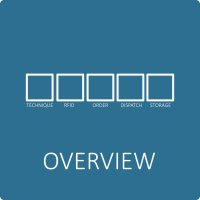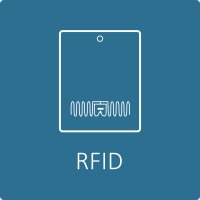Answers about labels and labelling solutions:
What is the difference between continuous and sheet labels?
Continuous labels on a roll are used for applications that require a continuous supply of labels. They are ideal for on-demand printing of small formats and automatic dispensers.
Sheet labels are used when larger formats are required or when the label is used as part of a document. In such cases, it should be considered whether a sheet-fed printer can be used.
What are tags?
Tags are attached to, but not glued to, a product. There is a wide range of attachment options: from metal clips, cable ties or wire to loop labels (e.g. for structural steel, plants or sacks) or threaded onto strapping.
Are there combinations of hang tags and labels?
There are. It's a bit more technically complex, but there are various techniques for incorporating adhesive fields or tapes into label production. This has advantages in terms of handling (e.g. applying and removing labels) and combines all the properties of our hang tags and self-adhesive labels..
What is a perforation?
It depends on the application. Usually the focus is on separating the labels. But there are also perforations that are only separated after a certain period of time. For example, to remove a section as proof of delivery. Or to fold the label. Technically, this is solved by the so-called cut/web ratio: how many 'teeth' the perforation has and how wide the webs are.
How long can labels be used for outdoor labelling?
This ranges from 'not at all' to almost infinite. Paper will last as a self-adhesive label if it is not subjected to mechanical stress. Plastics are sensitive to UV. But there are film labels that can be used for several years. This is achieved by appropriate pigmentation or protective varnishes/coatings. In the same way, adhesives are water-soluble dispersions with limited resistance, and solvent-based acrylates are resistant for years.
What materials does S+P Samson use as a manufacturer?
We have decades of experience in processing plastics. For all kinds of loads and applications. The special thing about S+P Samson is that we procure our own films on the world market and either process them ourselves or have them processed. The result is particularly resistant products that 'deserve' the name GRAPHIPLAST®.
Are the labels suitable for automation/robots?
Yes, they are. However, this is a very specialised area as it requires close cooperation with the manufacturer of the system. S+P Samson's wide range of films, adhesives and processing technology predestines it for such applications. In addition, S+P Samson has developed specific systems and solutions that make it much easier to bond a label during processing. With SecuBond® there are no adhesive residues and no stops due to adhesive leakage.
Are there also residue-free removable labels?
Of course there are. But there is always the question of whether the label still adheres well enough. This tension can be resolved with semi-permanent adhesives up to 100% removable adhesives. It all depends on the requirements.
What temperature can the labels withstand?
We need to distinguish between the temperature during application and the effects of further processing. There are solutions for almost all temperatures, but they are very costly and have limited adhesion. Ceramic-coated metal tags can withstand almost anything - but they are very specialised in terms of printing (C02 laser) and correspondingly expensive.
S+P Samson has dedicated itself to product labelling. With self-adhesive labels up to 350 °C and tags up to 580 °C.
Are stain resistant labels available?
S+P Samson has a portfolio of stain resistant labels. We offer tailor-made solutions for your pickling application. In order to select the right product for you, product tests at your premises are essential. Please do not hesitate to contact us.
Are there data sheets for the different labels?
Of course there are. Consultation should be sought beforehand as there are many different solutions. This will allow you to make a selection in advance and qualify suitable solutions for a test run.
What software do I need to print the labels?
There are different solutions - the question that needs to be clarified in advance is the origin of the data. For production-synchronised labelling, data is usually imported into a layout. Print software systems are common solutions for these requirements. You create a layout and define fields, and these fields are filled via an interface. We are happy to advise you.
Which printers can be used to print the labels?
In principle, any printer that can print labels. It is important that the label material is matched to the printer. The surface must be prepared for good adhesion of thermal transfer foil, toner or ink. S+P Samson specialises in thermal transfer and laser printing. The reason for this is the high resistance of these media.
What is the difference between thermal transfer and laser printing?
Thermal transfer ribbons are fragile and must be specified for the intended use. Changing the ribbons and setting up the printers requires training. TT printers have a dispensing edge and can therefore 'hand off' labels or process labels mechanically. Laser printers are 'plug and play' printers. They are easy and self-explanatory to use. By using multiple trays, the printing of label types or the merging of documents and labels can be controlled by software.
Which ribbon do I need for thermal transfer printing?
This depends on the quality of the surface of the label and how heavily the printed image will be used. The main components of ribbons are wax and resin. The higher the resin content, the more scratch resistant the print. Please contact us for more information.
What colour coding options are available?
1. Colour printing via the label printer
A classic example of multi-colour printing using a thermal transfer printer is GHS (Hazardous Substance Labelling) labels. This is two-colour printing. Colour printing with a laser printer is unlimited in terms of colour and print quality. Toner printing has very good UV resistance.
2. colour pre-print on the labels
Colour pre-printing is almost unlimited. For colour coding, bars or coloured stripes are commonly used. The alternative is pre-printed colour boxes or other geometries. These are 'activated' in the software by an X or other symbol..
How do I attach a tag?
For many applications there are special wire loops (clips). These are available commercially or from us. If a clip is not practical, the binding wire remains. This should be at least 1.5mm in diameter. Alternatively, cable ties can be used or the label can be hung as a loop label.
What is a barcode? What types of barcodes are there?
In a barcode, symbols (numbers/letters/special characters) are translated into modules or bars. The width and ratio of the bars to the empty spaces determine the symbolism/coding. Today, 2D codes are preferred. These have a higher storage density and greater redundancy. The usual industry standards, such as Code 128 for Odette receipts, must be observed.
What needs to be considered when reading barcodes from a distance?
The reader must be suitable for the application. Overly reflective foils (mirroring) create scattered light, which makes reading more difficult. For outdoor applications at greater distances, there are special foils that have a type of prismatic surface that makes reading at greater distances much easier.
Where can I get manual dispensers or dispensing systems for labels?
There are companies that specialise in labelling for various technical applications. As a supplier of special labels, S+P Samson works closely with various partners. Depending on the type of application, we will be happy to put you in touch with the machine manufacturers.
PE, PET or PVC? What is the difference?
PVC as a film is generally durable and has a limited temperature resistance (around 80°C). PE is a very soft, pliable material that tends to become brittle. PET is commonly used in packaging (transparent) and is characterised by greater rigidity and temperature resistance, depending on its thickness. The properties of all films depend on the 'finish/pigmentation' of the film type. These include UV resistance, opacity, antistatic properties and embrittlement.
How do I specify the correct pre-print colour?
For an accurate colour specification for spot colour, we need to know the required colour tone according to Pantone or HKS standards for mixed colours. Raster printing (colour in colour) is usually defined by the software when the artwork is created (screen density/colour components CMYK etc.). These data are decisive for the reproduction
How durable are the colours (colour adhesion/lightfastness)?
Colour manufacturers indicate lightfastness (UV) using the wool scale. This is highly dependent on the thickness of the ink layer (pigments) (full tone/screen) and the type of ink. Generally speaking, yellow/red has the lowest resistance and blue/black the highest. If there are specific resistance requirements, this information and the substrate to be printed can be used to check which of the printing processes will meet the requirement. For particularly high demands, additional UV-protective coatings or protective laminates are available.



